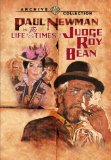| Reviews & Columns |
|
Reviews DVD TV on DVD Blu-ray 4K UHD International DVDs In Theaters Reviews by Studio Video Games Features Collector Series DVDs Easter Egg Database Interviews DVD Talk Radio Feature Articles Columns Anime Talk DVD Savant Horror DVDs The M.O.D. Squad Art House HD Talk Silent DVD
|
DVD Talk Forum |
|
|
| Resources |
|
DVD Price Search Customer Service #'s RCE Info Links |
|
Columns
|
|
|
Life and Times of Judge Roy Bean (Warner Archive), The
"For Texas and Miss Lillie!"
A violent, cartoonish, sentimental tall tale whopper of a Western―another of Huston's unsung gems from his later career. Warner Bros.' fantastic Archive Collection, the M.O.D. (manufactured on demand) service that caters to movie and TV lovers who want hard-to-find library and cult titles, has released The Life and Times of Judge Roy Bean, the 1972 comedy/drama oater from First Artists and National General Pictures, written by John Milius, directed by John Huston, and starring Paul Newman, Victoria Principal, Roddy McDowall, Jacqueline Bisset, Stacy Keach, Anthony Perkins, Tab Hunter, John Huston, Ned Beatty, and Ava Gardner. An underwhelming performer at the box office for superstar Newman, critics, too, were either non-plussed or outright hostile to Huston's take on the real-life "Law West of the Pecos." However, I've found this wonderfully funny, bizarrely energetic, wistfully sad Western gets better and better with each viewing...just ignore the last 20 minutes. An original trailer is included in this terrific widescreen transfer.
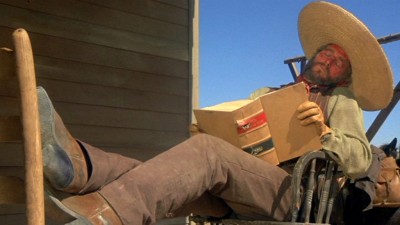
At the end of the 19th century, outlaw Roy Bean (Paul Newman) arrives at a hardscrabble, god-forsaken outpost on the lawless west side of the Pecos River in Texas. Hoping to find refuge among his fellow criminals, he is instead besieged by the bar's varmints and whores, who beat him, rob him, and string him by his neck to a runaway horse. Miraculously surviving when the rope breaks, and aided by beautiful Mexican girl Maria Elena (Victoria Principal, fresh and young and lovely), stiff-necked Roy Bean returns to the bar and with Old Testament fury, kills every last person in the bar. Brought out of his vengeful reverie by passing preacher Reverend LaSalle (Anthony Perkins), who buries the rotting corpses, Roy Bean passes the time reading the abandoned law book he found in the bar. Christening all the surrounding land Vinegaroon County, and declaring himself the new Law West of the Pecos, self-appointed Judge Roy Bean tells the frightened Mexican peasants there's going to be law and order and peace in this new land ("...and I don't care who I have to kill to get it!") as he sets up shop, running a bar, gambling saloon, whorehouse, and courtroom. Aided by his outlaw band of marshals, Judge Bean does indeed bring peace to this desert wasteland, but at a stiff price. Harsh fines await most, or the end of a rope if someone is an "obvious" criminal...or instant death by gunfire to anyone who insults Bean's muse, his goddess, his unobtainable, untouchable romantic ideal: "The Jersey Lily," English actress Lillie Langtry (Ava Gardner), who adorns the walls of his The Jersey Lily bar. A more tangible form of love comes to the Judge in his relationship with Maria, as well as his Watch Bear (Bruno), a grizzly bear left at The Jersey Lily by Grizzly Adams (John Huston). Idyllic times, however, are short-lived on the disappearing frontier: progress, in the form of prissy, sly attorney Frank Gass (Roddy McDowall), threatens to destroy Judge Roy Bean's self-made world.
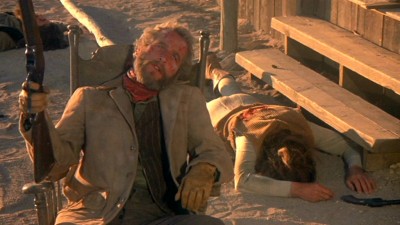
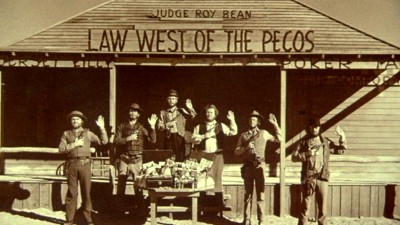
A particular favorite of mine ever since I saw it at the drive-in back in '72, The Life and Times of Judge Roy Bean is a big, beautiful mess of a Western, at times flat-out brilliant in context and execution (the movie's first 15 minutes are as good as anything Huston ever did), and at other times misshaped or outright misconceived (the film's ill-advised final act is an unnecessary shambles of an anti-climax). A barely-moderate hit at the box office, The Life and Times of Judge Roy Bean wasn't an assured success just because Paul Newman scored such a massive Western winner only three years before with Butch Cassidy and the Sundance Kid. In fact, The Life and Times of Judge Roy Bean was just another in a worrying line of critical and/or popular failures for the actor at this mid-point in his career, starting with the abysmal The Secret War of Harry Frigg in 1968 and continued through Winning, WUSA, Sometimes a Great Notion, Pocket Money (a modern Western that failed to click with anyone the same year as Bean), and The Mackintosh Man (made with director Huston right after Bean). Audiences and critics certainly acknowledged Newman's place as one of the few genuine "superstar" performers of the late 60s and early 70s, a point driven home with his staggering trio of super-smashes: Butch, The Sting, and The Towering Inferno. However, Newman's name alone couldn't sell a movie to uninterested audiences or cranky critics. This was even more true in 1972 of director John Huston, whose career was always up and down with audiences and critics, and who had just come off a string of critical and/or commercial losers including The Bible: In the Beginning, Casino Royale, Reflections in a Golden Eye, Sinful Davey, A Walk with Love and Death, the brilliant, unsung The Kremlin Letter, and 1972's Fat City, which may have been ecstatically received by critics...but which didn't make a dime at the box office.
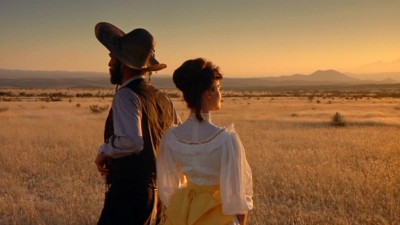
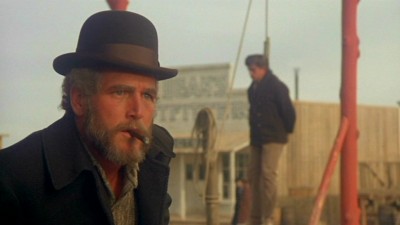
According to what I've read, there's a difference of opinion as to who should take the majority credit for how The Life and Times of Judge Roy Bean turned out. Huston claims he collaborated daily with screenwriter John Milius, working together on scenes each day, both of them making up the film as it went (Milius was hot off Robert Redford's Western hit, Jeremiah Johnson and some uncredited work on Dirty Harry, before he would score further with Magnum Force and his own directorial debut, Dillinger). Milius on the other hand says his screenplay was mangled by director John Huston, who supposedly eliminated much of the darkness and complexity of the Bean character in favor of comic outrageousness and sentimentality. Seeing as how we're talking about two of Hollywood's most notorious bullsh*t artists, it's probably a safe bet to say the truth is somewhere in the middle, but anyone familiar with Huston's work will most likely say his vision dominates here. That brash, beautiful, aching, Irish longing for storytelling, for boasting, for bravado, for high spirits, and for sudden, sickly violence...and the melancholy and sadness that inevitably follows in The Life and Times of Judge Roy Bean―that's Huston.
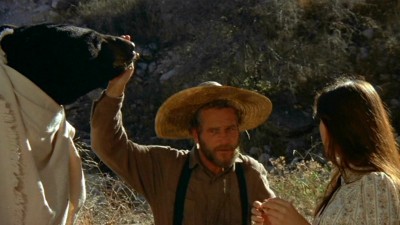
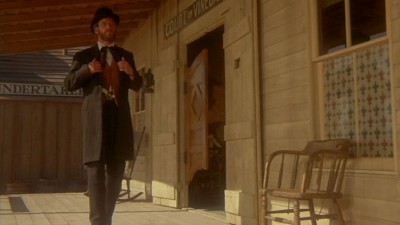
The opening act of The Life and Times of Judge Roy Bean is a remarkable progression of textures and styles, showing Huston (and/or Milius?) at his most supple and playful. As the credits roll against the stunning Arizona backdrops courtesy of cinematographer Richard Moore (Thunderball, Sometimes a Great Notion), we hear composer Maurice Jarre's (Lawrence of Arabia, The Train) soft, melancholic theme as the sun goes down on the approaching Roy Bean―a nice foreshadowing of what's ultimately to become of him. This is followed by Huston and Moore photographing an unseen Bean approaching the bar's entrance, his iconic, myth-making shadow falling ominously on his own "wanted" poster...before Huston's impish sense of humor shines through as Bean draws a moustache on his photo. Once inside, Huston creates a strange, still menace, highlighted by the Fellini-esque sight of Victoria Principal washing an enormously fat whore in a tub three sizes too small, before things get scary/funny as the strong, vicious whores surround Bean and attack him, beating him while literally shaking him upside down until his coins drop out (the first of many such cartoon images). Huston then switches into an even stranger, delightfully cartoonish assault by stiff-necked Bean (that crooked neck is the perfect visual equivalent of Huston's cynical, cockeyed worldview ) on his tormentors, filled with Looney Tunes-type slapstick and gags that are perversely, grotesquely hilarious (the guy wandering into full close-up to impatiently fire his pistol before drawing, blowing off his own crotch). Huston cuts to a camera outside, slowly tracking in on the bar as various parts of the walls and roof are blown off, with outlaws screaming like cartoon characters, all weirdly, wonderfully contrasted by Newman's Old Testament fury and Jarre's chilling musical cues. Switching gears yet again, Huston shows Bean's obsession to kill every last one of the bar denizens as he sits outside all night, in a rocker, in a rain storm―armed, and waiting to kill anyone who returns. And if all of that isn't enough to discombobulate the viewer, Huston then segues right into tall tale storybook-telling mode by having Tony Perkins show up as (what else) a thoroughly off-center preacher who narrates his brief encounter with Bean...from heaven, no less.
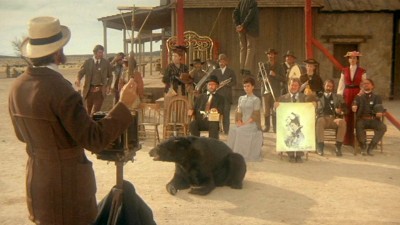
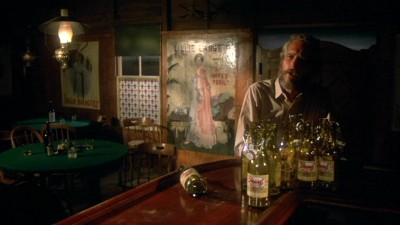
Perhaps the critics and the public locked onto that wildly-shifting mélange of an opening and in trying to select what, exactly, The Life and Times of Judge Roy Bean was all about, then had trouble connecting with the rest of it, claiming it was a jagged, violent comic book with no focus (they could perceive) throughout its supposedly random vignettes. If so, that's a view that entirely misses the point of the movie (jesus, read Ebert's completely irrelevant take on this movie and then try and figure out how this guy got so influential): a weird, contrary mixture of the gen-u-wine American Tall Tale...hosted by one of Huston's patented "grand losers." Huston's Olde West is the America built by self-made, self-invented, half-mad dreamers like Bean, who fashioned a country out of whole cloth using their drive and ego alone...only to have the inevitability of fate intrude and crush their brief dreamer's idyll. The very civilization that Bean states will come to Vinegaroon does come, in the noxious collaboration between self-righteous reformed whores who turn their outlaw husbands into henpecked pussies, and an effeminate attorney, no less ("The last time that bear ate an attorney, it had the runs for 33 days," says Bean). The law as written crushes the wild and wooly and crazy individualism of Bean's, giving way to a soul-deadening tameness...and an even more perverted application of said law in the service of power.
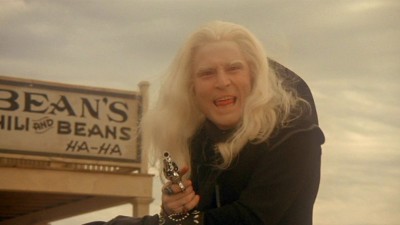
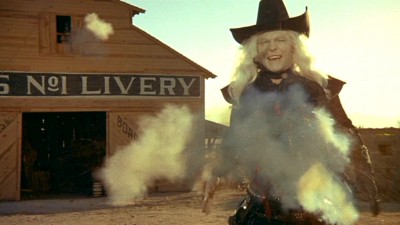
When Bean presides over Watch Bear's funeral (a potent physical manifestation of Bean's and the West's essential wildness), he laments that it's "all changed" and that no one who comes later will know what it took to build what he started (no matter how spurious those efforts were in genesis). And he's right. Forgetting the last foolish 20 minutes of the movie, Bean gradually comes up short, as he must in Huston's worldview, in his quest to build his own Eden of poker playing, beer-drinking, and love with Maria and companion Watch Bear. Despite the obvious sympathy Huston has for his losers, he isn't sentimental to the point of letting them continue on in denial. None of Huston's losers in The Life and Times of Judge Roy Bean wind up "safe" with their illusions (when Tab Hunter, of all people, is hung for killing an Asian, he doesn't believe he's guilty for that crime...but he does allow he's guilty for the other murders he's committed). Of course the biggest illusion of all in The Life and Times of Judge Roy Bean is Bean's romantic idealization of Miss Lillie Langtry, but Huston won't even leave that alone: when Bean first starts to pontificate about her, Huston has a man gobbling like a turkey run in while Bean is rhapsodizing. Huston lets us see Bean at the apex of his happiness/delusion (the picnic scene featuring Andy Williams crooning Marmalade, Molasses, and Honey, a scene which critics hated because they thought it was ripping off Butch's Raindrops musical montage) and gives us an outrageous tall tale cartoon sequence to illustrate Bean's legendary, mythic status as a killer (Stacy Keach's hilariously scary Albino Bad Bad Bob, who drinks boiling coffee, orders his horse cooked "blue" because he's hungry, and who gets a hole blown in him you can see through), before Huston pulls the rug out from under Bean. When Miss Lillie is to appear in San Antonio, the great Judge Roy Bean is treated like a nobody when he insists on a ticket at the sold-out theatre, before he's suckered like a common rube and mugged by Anthony Zerbe; the illusion of his fame is gone. Returning home, he finds Maria dying after giving birth to their baby, Rose; the illusion of his love is gone (Newman is particularly good here). And when he tries to hang the drunken doctor who came to late to save her, he's stopped by Gass, who's now the mayor, who tells him he's not in charge any more; the illusion of Bean's power is gone. Bean sits tiredly in his rocker as we hear a brief refrain of Marmalade, Molasses and Honey (his happiest time), before he gets up and rides off into the history books for good, taking nothing with him...because he has nothing anymore. A Huston loser, through and through.
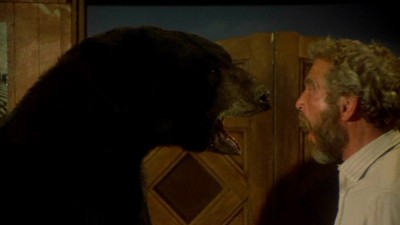
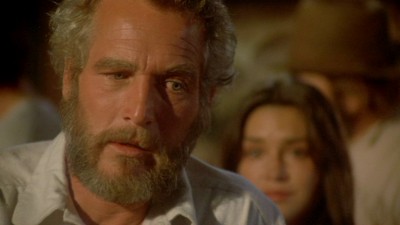
And that's where the movie should have ended, with the brief coda of Ava Gardner coming back to Vinegaroon years later, and reading Bean's last letter to her, pledging undying love, giving the viewer a tender, sad, powerfully romantic elegy for lost illusions and long-past times. Brilliant. But I didn't edit The Life and Times of Judge Roy Bean, unfortunately...so imbetween these two sequences we get this exposition-heavy, clumsily constructed, ridiculous re-boot of the Bean legend as he comes back to Vinegaroon-as-oil-boom town to meet his equally willful daughter, Rose (a simply awful Jackie Bisset, who can't hide her English accent to save her life), where Milius and Huston can spout their progressive bullsh*t about how evil commerce is before there are numerous pointless explosions set-off by an aged Newman, seeking "justice" of some sort. And what "justice" would that be? Justice against progress? That's what Bean said he wanted all along. Then...how about the perversion of justice? Nobody was more perverse with the notion of justice than Bean the "hanging judge." Can't figure it out, then, exactly what old Bean is railing about? That's okay...neither, obviously, could Milius and Huston. They already made all their points about myth, and civilization, and individualism long before this sequence...so why beat it into the ground (and ineffectually, at that)? Who knows. Maybe somebody at the studio said, "This needs a big finish! Some action!" It's possible. It's just too bad they forgot what they were trying to say in the first place.
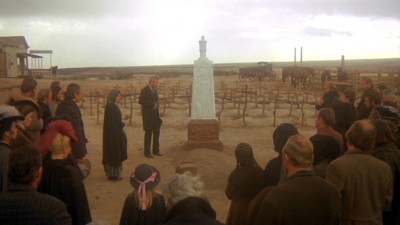
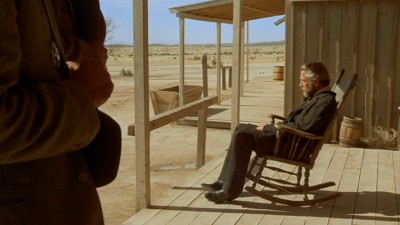
The DVD:
The Video:
The anamorphically-enhanced, 1.85:1 widescreen image for The Life and Times of Judge Roy Bean looks terrific, with beautifully subtle, correctly-valued color, a sharp image, and little or no screen anomalies.
The Audio:
The Dolby Digital English split mono audio track is fine, with little or no hiss and a nice re-recorded level. Subtitles are available in English, French, and Spanish (unusual for a Archive collection).
The Extras:
An original trailer for The Life and Times of Judge Roy Bean is included.
Final Thoughts:
Misunderstood, neglected (...and partially mangled) masterpiece from director John Huston, screenwriter John Milius, and star Paul Newman (in one of his best performances). If you just skip that last twenty minutes of the movie and go right from Bean leaving the Olde West, and Miss Lillie Langtry reading his love letters years later, you'll experience one of Huston's saddest, funniest, most alive movies, where illusion, no matter how momentarily sweet, must shatter in the face of reality and worse, fate. I'm highly, highly recommending The Life and Times of Judge Roy Bean.
Paul Mavis is an internationally published movie and television historian, a member of the Online Film Critics Society, and the author of The Espionage Filmography.


|
| Popular Reviews |
| Sponsored Links |
|
|
| Sponsored Links |
|
|
| Release List | Reviews | Shop | Newsletter | Forum | DVD Giveaways | Blu-Ray | Advertise |
|
Copyright 2024 DVDTalk.com All Rights Reserved. Legal Info, Privacy Policy, Terms of Use,
Manage Preferences,
Your Privacy Choices | |||||||









